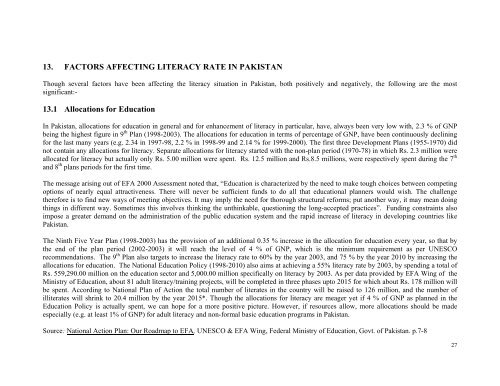Literacy Trends in Pakistan - UNESCO Islamabad
Literacy Trends in Pakistan - UNESCO Islamabad
Literacy Trends in Pakistan - UNESCO Islamabad
You also want an ePaper? Increase the reach of your titles
YUMPU automatically turns print PDFs into web optimized ePapers that Google loves.
13. FACTORS AFFECTING LITERACY RATE IN PAKISTANThough several factors have been affect<strong>in</strong>g the literacy situation <strong>in</strong> <strong>Pakistan</strong>, both positively and negatively, the follow<strong>in</strong>g are the mostsignificant:-13.1 Allocations for EducationIn <strong>Pakistan</strong>, allocations for education <strong>in</strong> general and for enhancement of literacy <strong>in</strong> particular, have, always been very low with, 2.3 % of GNPbe<strong>in</strong>g the highest figure <strong>in</strong> 9 th Plan (1998-2003). The allocations for education <strong>in</strong> terms of percentage of GNP, have been cont<strong>in</strong>uously decl<strong>in</strong><strong>in</strong>gfor the last many years (e.g. 2.34 <strong>in</strong> 1997-98, 2.2 % <strong>in</strong> 1998-99 and 2.14 % for 1999-2000). The first three Development Plans (1955-1970) didnot conta<strong>in</strong> any allocations for literacy. Separate allocations for literacy started with the non-plan period (1970-78) <strong>in</strong> which Rs. 2.3 million wereallocated for literacy but actually only Rs. 5.00 million were spent. Rs. 12.5 million and Rs.8.5 millions, were respectively spent dur<strong>in</strong>g the 7 thand 8 th plans periods for the first time.The message aris<strong>in</strong>g out of EFA 2000 Assessment noted that, “Education is characterized by the need to make tough choices between compet<strong>in</strong>goptions of nearly equal attractiveness. There will never be sufficient funds to do all that educational planners would wish. The challengetherefore is to f<strong>in</strong>d new ways of meet<strong>in</strong>g objectives. It may imply the need for thorough structural reforms; put another way, it may mean do<strong>in</strong>gth<strong>in</strong>gs <strong>in</strong> different way. Sometimes this <strong>in</strong>volves th<strong>in</strong>k<strong>in</strong>g the unth<strong>in</strong>kable, question<strong>in</strong>g the long-accepted practices”. Fund<strong>in</strong>g constra<strong>in</strong>ts alsoimpose a greater demand on the adm<strong>in</strong>istration of the public education system and the rapid <strong>in</strong>crease of literacy <strong>in</strong> develop<strong>in</strong>g countries like<strong>Pakistan</strong>.The N<strong>in</strong>th Five Year Plan (1998-2003) has the provision of an additional 0.35 % <strong>in</strong>crease <strong>in</strong> the allocation for education every year, so that bythe end of the plan period (2002-2003) it will reach the level of 4 % of GNP, which is the m<strong>in</strong>imum requirement as per <strong>UNESCO</strong>recommendations. The 9 th Plan also targets to <strong>in</strong>crease the literacy rate to 60% by the year 2003, and 75 % by the year 2010 by <strong>in</strong>creas<strong>in</strong>g theallocations for education. The National Education Policy (1998-2010) also aims at achiev<strong>in</strong>g a 55% literacy rate by 2003, by spend<strong>in</strong>g a total ofRs. 559,290.00 million on the education sector and 5,000.00 million specifically on literacy by 2003. As per data provided by EFA W<strong>in</strong>g of theM<strong>in</strong>istry of Education, about 81 adult literacy/tra<strong>in</strong><strong>in</strong>g projects, will be completed <strong>in</strong> three phases upto 2015 for which about Rs. 178 million willbe spent. Accord<strong>in</strong>g to National Plan of Action the total number of literates <strong>in</strong> the country will be raised to 126 million, and the number ofilliterates will shr<strong>in</strong>k to 20.4 million by the year 2015*. Though the allocations for literacy are meager yet if 4 % of GNP as planned <strong>in</strong> theEducation Policy is actually spent, we can hope for a more positive picture. However, if resources allow, more allocations should be madeespecially (e.g. at least 1% of GNP) for adult literacy and non-formal basic education programs <strong>in</strong> <strong>Pakistan</strong>.Source: National Action Plan: Our Roadmap to EFA, <strong>UNESCO</strong> & EFA W<strong>in</strong>g, Federal M<strong>in</strong>istry of Education, Govt. of <strong>Pakistan</strong>. p.7-827
















